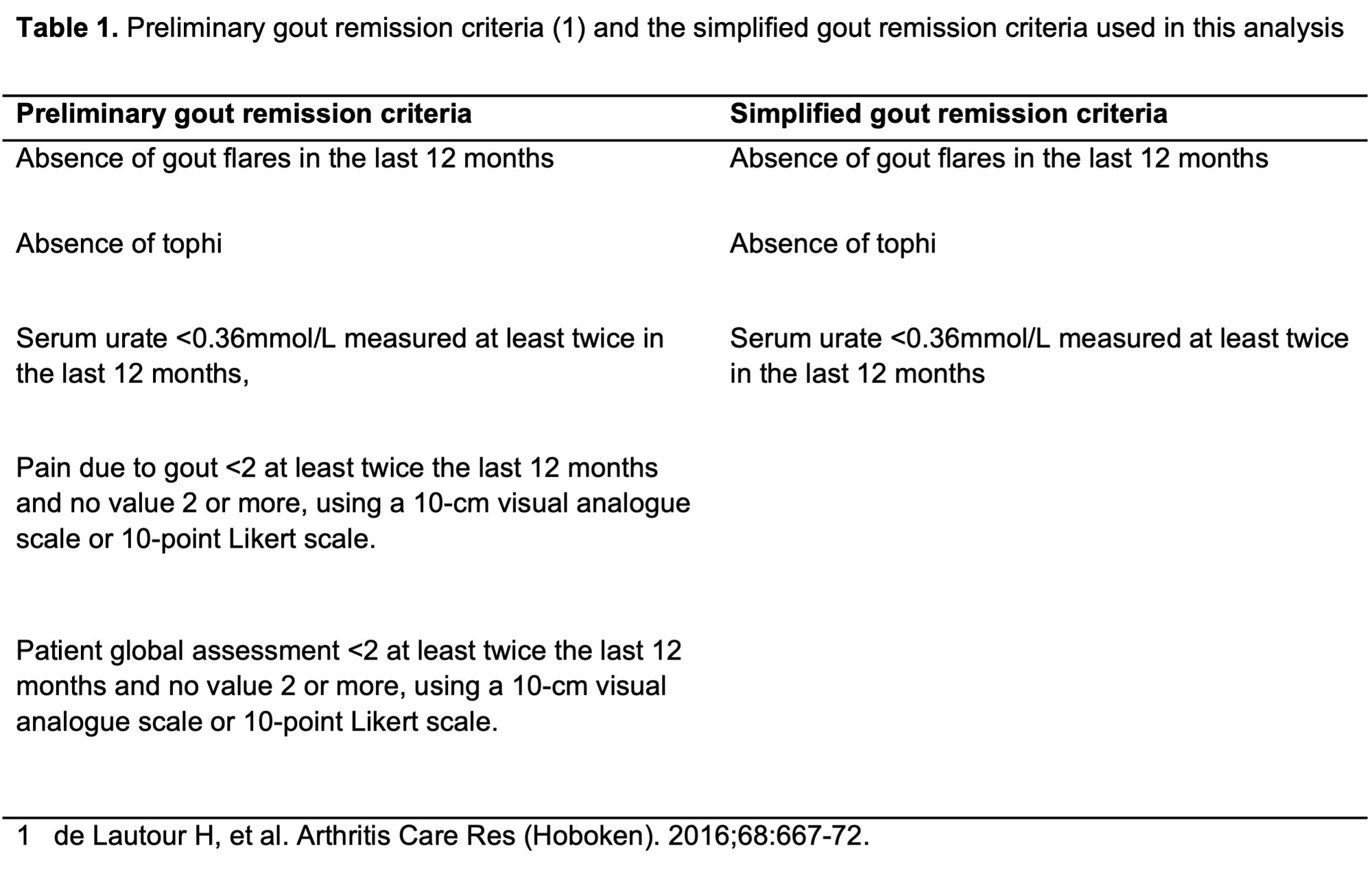Session Information
Session Type: Poster Session B
Session Time: 9:00AM-11:00AM
Background/Purpose: Preliminary gout remission criteria have been developed using OMERACT core outcome domains for long-term gout studies. This study aimed to identify variables that predict gout remission in patients receiving intensive urate-lowering therapy.
Methods: We analysed data from a 2-year, double-blind randomized controlled trial of 104 people with erosive gout. Participants were randomized to an intensive serum urate target of < 0.20mmol/L or a standard target of < 0.30mmol/L using oral urate-lowering therapies (allopurinol, probenecid, benzbromarone, and febuxostat). All participants had a dual energy CT (DECT) scan of the feet and ankles at baseline. The proportion of participants achieving gout remission according to the preliminary gout remission criteria and simplified gout remission criteria without the patient reported outcomes at Year 1 and Year 2 was calculated (Table 1). The simplified gout remission criteria were developed following a qualitative study examining patient perspectives of gout remission. Logistic regression models were used to evaluate independent predictors of gout remission at Year 2; these included baseline variables associated with remission in bivariate analysis and baseline values for each remission domain.
Results: The preliminary gout remission criteria were fulfilled in 11 (11%) of all participants at Year 1 and 21 (23%) of all participants at Year 2. The simplified criteria were fulfilled in 26 (27%) participants at Year 1 and 40 (44%) participants at Year 2. Similar rates of remission were observed in the two randomization groups (P >0.99). In regression models, baseline DECT urate volume was a significant predictor of gout remission at Year 2, using either criteria. Each one cm3 increase in the baseline DECT urate volume decreased the odds of fulfilling the preliminary gout remission criteria with an odds ratio of 0.65 [95% CI 0.44-0.96], P=0.029. Likewise, each one cm3 increase in the baseline DECT urate volume decreased the odds of fulfilling the simplified gout remission criteria with an odds ratio of 0.56 [95% CI 0.39-0.77], P< 0.001.
Conclusion: In people with erosive gout on urate-lowering therapy, high baseline MSU crystal volume measured by DECT is associated with lower odds of gout remission after two years of treatment, defined by both the preliminary gout remission criteria and simplified gout remission criteria.
To cite this abstract in AMA style:
Tabi-Amponsah A, Stewart S, Gamble G, Doyle A, Son C, Latto K, Stamp L, Taylor W, Horne A, Dalbeth N. Dual Energy Computed Tomography (DECT) Urate Volume Predicts Fulfillment of Gout Remission After Two Years of Intensive Urate-Lowering Therapy [abstract]. Arthritis Rheumatol. 2023; 75 (suppl 9). https://acrabstracts.org/abstract/dual-energy-computed-tomography-dect-urate-volume-predicts-fulfillment-of-gout-remission-after-two-years-of-intensive-urate-lowering-therapy/. Accessed .« Back to ACR Convergence 2023
ACR Meeting Abstracts - https://acrabstracts.org/abstract/dual-energy-computed-tomography-dect-urate-volume-predicts-fulfillment-of-gout-remission-after-two-years-of-intensive-urate-lowering-therapy/

